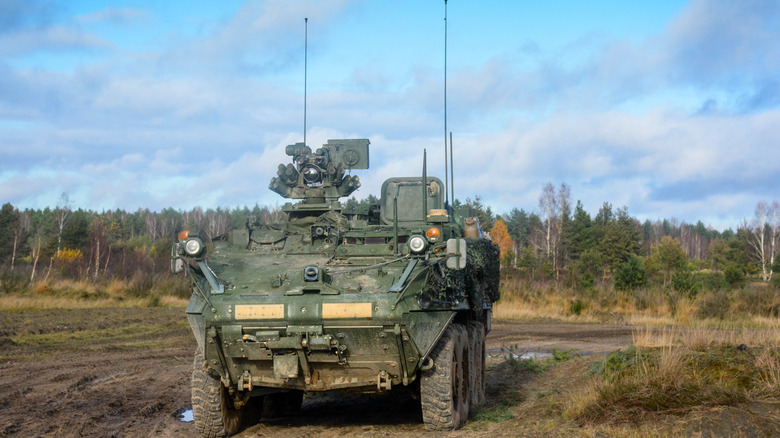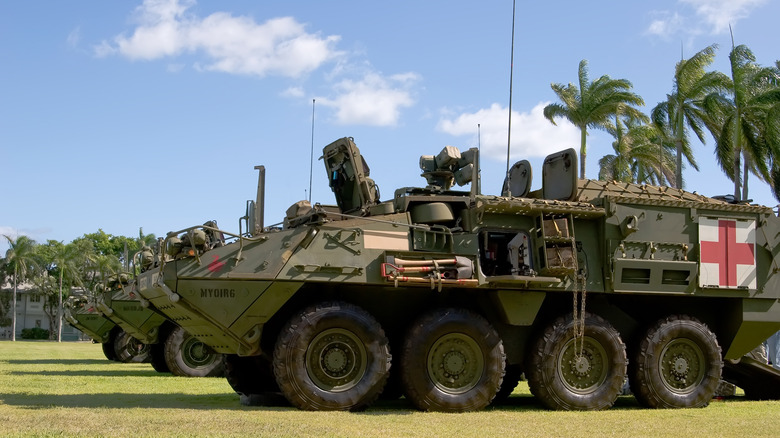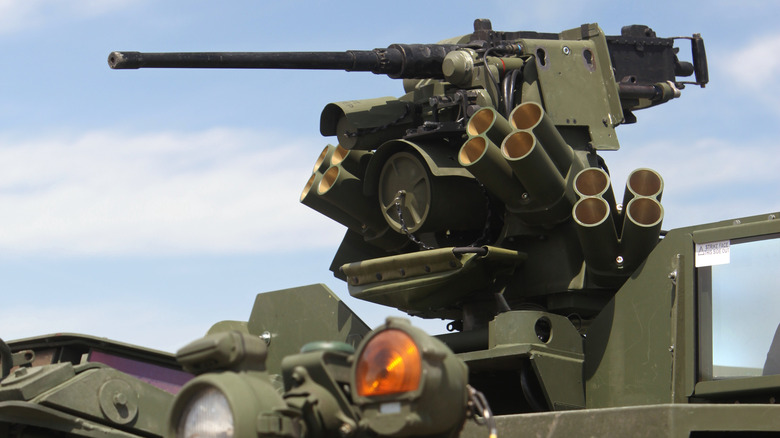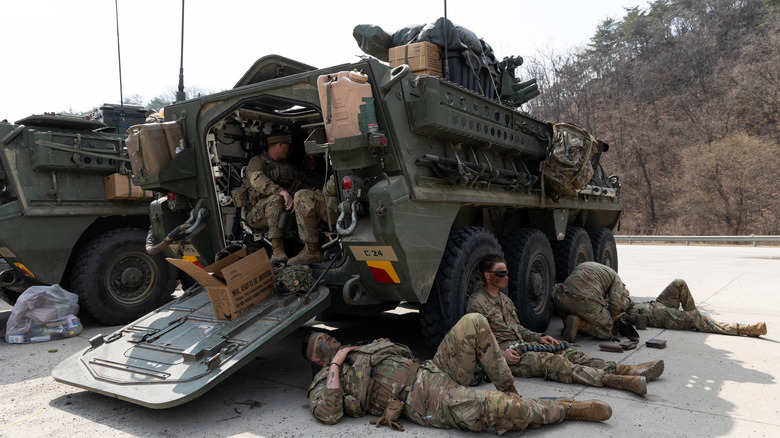Here's What Makes The Army's Armored Stryker Incredibly Versatile
Military vehicles come in all shapes and sizes. Those on the land, as well as in the seas and skies, have a range of different applications, from delivering all-out destructive force to performing quieter, subtler, more clandestine operations. No one machine can perform every potential role, just as no athlete, however world-renowned, can play every position on the pitch by themselves.
This isn't to say, of course, that there aren't those vehicles that can provide utility in multiple different ways. Something more general-purpose, after all, can be a great boon for any military in terms of the practicality of deployment. The United States Army's Stryker is a vehicle designed with more than one role in mind, something like a very advanced take on the M8 Greyhound.
Let's take a look at the creation of the Stryker, the different battlefield tasks it could perform, and the unfortunate shortcomings that would prove to limit this armored vehicle's once-impressive utility.
When was the Stryker introduced?
The need for a vehicle like the Stryker became apparent in the wake of the Cold War. In 2003, "The Objective Force: A Holistic Approach To Army Transformation, (PDF)," LTG John M. Riggs stated that, without the Soviet Union, "the United States no longer faces a peer competitor capable of matching U.S. military capabilities." Sheer might alone, however, is only one part of the puzzle, and nothing without the ability to deploy it effectively and efficiently. Lighter-armored vehicles such as the Willys M38A1 have proven their utility, but also their limitations.
LTG Riggs went on to state that the U.S. military's focus was to become a "lighter, more agile, more lethal force," one that could adapt, respond, and deploy to both expected and unexpected dangers. A vehicle that could help provide these things, offering maneuverability, transportation, firepower, and defensive capabilities, was called for.
The Interim Armored Vehicle, once just a placeholder for the fruits of the Future Combat System (which never materialized), would become the Stryker. It was created by General Dynamics Land Systems and followed shortly after 2001 Canada LAV III. The Stryker, which began its military career proper in Iraq in November 2003, would see a number of equipment upgrades and modifications and new models over the course of its operational life. They'd allow the family of vehicles to serve a wide range of roles.
What could this versatile machine do?
The specifications of the Stryker vary quite widely, depending on the configuration in question. The M1126 Stryker infantry carrier vehicle, which could transport nine soldiers in addition to its two crew members, weighs around 19 tons yet is capable of a rather sprightly speed of 62 mph (on roads that could support it). Though this variant is designated for transport, it isn't simply passive: Its armaments include an MK240 machine gun and an MK19 grenade launcher.
The more offensively oriented M1128, an MGS, was first deployed by the U.S. Army in 2007. With a 105-millimeter gun, it served as something of a tank-lite, further indicating that the Stryker vehicles are anything but simply maneuverable troop transports. Further additions to the Stryker family included a Nuclear Biological Chemical Reconnaissance Vehicle and a Medical Evacuation Vehicle, the latter of which was fielded two years after the MGS. It has room for up to four litters inside and is crewed by a trio of medical personnel.
There are a total of 18 different variants of the Stryker, seven of which are equipped with a Double-V hull. The family at large, then, could serve a variety of needs: offensive, defensive, supportive, on the battlefield itself or not. Certain shortcomings of the Stryker have become apparent, though, leading it to become increasingly obsolete.
The Stryker's shortcomings and legacy
That very versatility, however, may have proven to be the Stryker's undoing in some key areas. Though it has been adapted to better fit certain objectives, it can be outperformed by those vehicles dedicated to such roles, and the cross-compatibility meant that the systems are rather similar, easily becoming outdated.
In May 2021, for instance, it was announced that the Stryker MGS would cease use. Defense News quotes an army press release as stating, "comprehensive analysis highlighted obsolescence and systemic issues with the system's dated cannon and automatic loader." Exacerbating this issue was the fact that, as a lighter vehicle, the Stryker's armor was limited and easier to penetrate with the likes of explosives.
There's no denying that the Stryker is a versatile vehicle family indeed. In its various forms, it has continued to be augmented, with the Dragoon Stryker (and its potent Bushmaster cannon) debuting in 2017 and the mobile short-range air defense Stryker being introduced in 2021. All in all, an astonishingly versatile military vehicle.



